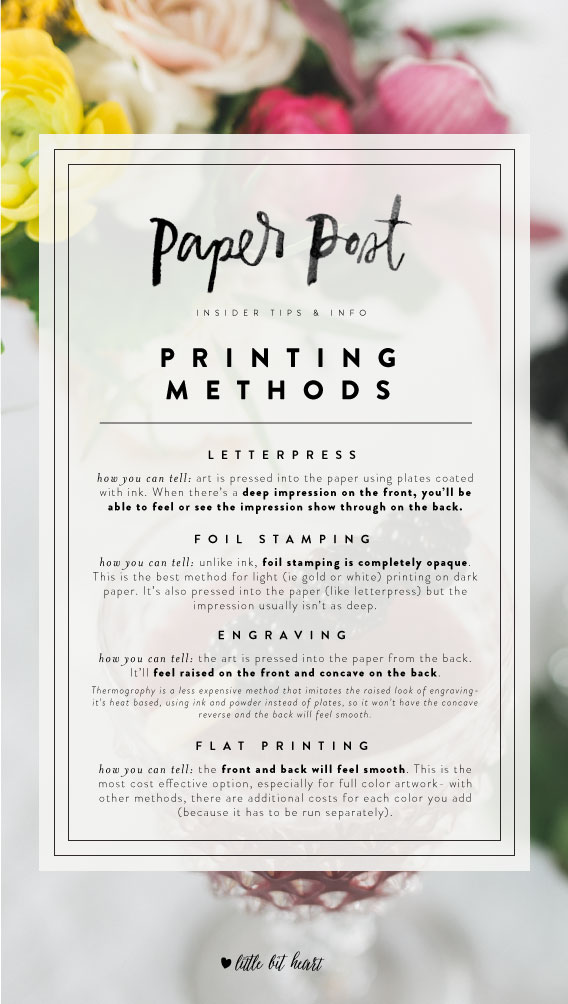
Printing methods- which is best for your style and budget? What does each one look or feel (yes, we’d be the paper obsessed guests feeling your wedding invitation!) like? What DO all those words I keep hearing about mean anyway?
While this isn’t in any way an exhaustive guide, these tips are a great jumping off point into the wide wide world of printing. Just like around a poker table, each of these players has a “tell”- the dead giveaway that what you’re looking at is engraving, not thermography, or letterpress, not flat printing.
Letterpress
The tell: lettering or artwork is pressed into the paper. When there’s a deep impression on the front, you’ll be able to feel or see the impression show through on the back.
Run your finger across the lettering on a wedding invitation. If it’s dipping into the paper, that’s letterpress. Straight out of the 15th century, letterpress has made a huge comeback- particularly with wedding stationery- thanks to its gorgeous tactileness (made up word alert) and dedicated presses that are adapting this printed craft for modern stationery (that deep impression we love? That’s a relatively new thing you’d never see on an old-school letterpress piece). Letterpress, like engraving, is pressure based with a relief result- the plate pushing against the paper creates printing that you can feel.
Budget-wise: Expect a letterpress package to be at least double the cost of a flat printing one. This can vary depending on the amount of colors (each color is another set of plates and another run through the press), the type of paper you choose, the number of pieces in your suite, and if you’re adding any additional embellishments to your full set.
Engraving
The tell: the lettering or artwork is pressed into the paper from the back. It’ll feel raised on the front and concave on the back.
Back to that wedding invitation (or business card or whatever printed piece it is that you’re wondering about). When you run your finger across it, are the letters raised? Flip it over and check the back- is there a reverse impression into the paper? Yes? That’s engraving. Engraving can be beautifully formal- it’s a traditional wedding invitation printing method- and it can also shine in creative, modern designs (it handles light ink on dark paper like a champ). Also pressure based with a relief result, it’s kind of like the opposite of letterpress: the artwork’s raised, not impressed.
Budget-wise: The biggest budget hurdle with engraving is that it may not be cost effective for smaller runs. Again, your full set price will depend on several factors, including colors, papers, pieces, and embellishments.
Thermography is a less expensive method that mimics the look of engraving (to us, it doesn’t look quite as crisp)- it’s heat based, using ink and powder instead of plates, so it won’t have the concave reverse and the back will feel smooth.
Flat printing
The tell: both the front and back feel smooth. This is the most cost effective option.
Feels smooth on the front and on the back? That’s flat printing, which is an umbrella term for several different methods- offset, digital, laser, or inkjet are words that you might hear to describe printing or printers, and what they all have in common is that they’re all “flat”- no impression. Your stationer will know which flat printing method is best for your budget, paper and style. Flat printing is also where color is really going to wow you- with digital printing, you’ll get the full spectrum without any added color charges (with other methods, there are additional costs for each color you add because each color is a separate print run).
Budget-wise: Most likely, a form of flat printing is the least expensive option. Digital printing is more affordable and cost effective (it has a lower per piece price) than offset printing, particularly with small run jobs. Going with flat printing instead of a more expensive method may open up your budget to splurge on a unique bellyband or calligraphy, for example.
background image: victoria selman photography

So many print methods, so little time! I love how you broke each method down, super easy to follow, and I understand each method WAY better than I did before! Excellent post!
this is a great post! very informative and helpful
This is something everyone should know about, thanks for breaking it down
Printing options can be so confusing, so this is a very nice breakdown!
Such a helpful post ~ love your visuals! :)
Such an incredibly helpful post :) All brides need to read this!
This is such a great post – I never knew what the difference was! :) Great work ladies!
This was great information. Thanks!
Nice read, I just passed this onto a colleague who was doing a little research on that. And he just bought me lunch because I found it for him smile So let me rephrase that: Thanks for lunch!
You ladies do such a wonderful job, every single time! This is a great summary of a very frequently asked question!
Sending this on to a few people straightaway. Thanks, ladies, for once again sharing such helpful information for people new to well-designed and printed papergoods!!